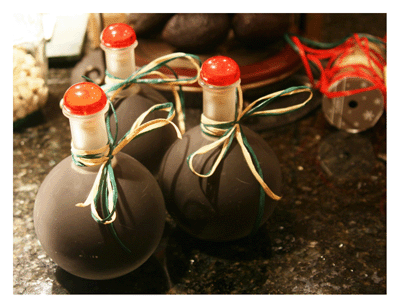|
Homemade Liqueurs:
|
 |
With no special equipment required, homemade liqueurs are very easy to make.
At the Base of it All
Most homemade liqueurs start with vodka. This spirit is an ideal base for liqueurs because it's colorless and flavorless, making it the perfect blank canvas. Try creating some of the most popular liqueur flavors, like coffee, amaretto, and Irish cream--they all rely on vodka for their kick. Or, you may prefer to infuse the subtle essences of herbs, spices or fruit. Don't be afraid to experiment with rum, tequila, gin, brandy, and whiskey infusions as well.
Whichever alcohol you decide to use as your base, choose a decent-quality brand. There's no need to break the bank for the premium varieties, but avoid the cheapest ones if you want to enjoy your liqueurs straight.
Pick a Flavor
There are two ways to add flavor to liquor:
Mix flavored extracts right into liquor.
Choose the flavoring ingredients in their raw form and allow them to steep in the alcohol for days or weeks.
Using extracts is the fastest way to make a batch of liqueur, and there are a few cases (e.g. with almond extract), where this is the best way to achieve the flavor you're after. More often than not, though, you will get the best results when you slowly infuse the liquor with fresh ingredients. For example, lemon cordial made with fresh lemon zest will taste much better than something made with lemon extract. Using fresh ingredients also allows you to introduce more variety; you won't be able to find as wide a variety of extracts and essences as you will of fruits and herbs and spices.
Infusing liquor is not an exact science, but more a matter of taste. Infuse each flavor to suit your own preferences and if it ends up tasting too strong, you can always dilute it with additional liquor.
Here are some flavoring ideas:
Fruit: Orange zest, lemon zest, kumquats, cranberries, raspberries, blackberries, blueberries, strawberries, cherries, peaches, tart apples, pineapple, pomegranate seeds, dried apricots, or dried sour cherries. Whole fruit should be sliced and/or mashed to allow the juices to escape and let the liquor come in contact with as much surface area as possible. Leave the skin on for maximum flavor.
Herbs and spices: Vanilla beans, coriander seeds, peppercorns, hot chiles, lemongrass, cinnamon sticks, cloves, nutmeg, whole coffee beans, dill, thyme, basil, tarragon, rosemary, or even garlic. Be sparing with the cloves and nutmeg: too much of these ingredients can produce a numbing effect in your mouth! Try combining a couple of different flavors in the same batch: how about apple-cinnamon, chile-lemongrass, lemon-tarragon, orange-cranberry, or raspberry-vanilla? Just don't try to pack too many different things into one bottle, or you won't be able to distinguish the flavors.
Give it a Rest
Once you've chosen your alcohol and your flavorings, simply combine them.
- Put flavorings right into the liquor, or any glass or earthenware jar/bottle with a tight-fitting lid.
- Keep the container in a dark place and leave it at room temperature. If you don't have a dark cupboard in your house, put the bottles in a paper grocery bag and stir or rotate them a
- Depending on how potent your flavorings are, you'll need to let them steep for anywhere from a day to a few weeks. Most fruit needs a full two to four weeks for all the flavor to be transferred to the alcohol, whereas chiles, garlic, and most fresh spices only need a couple of days.
Smell and taste the infusions to decide when each is ready.
Strain Your Resources
|
|
Add a Little Sweetness
When sweetening your liqueurs, don't add sugar directly to the alcohol--it will take too long to dissolve and you won't be able to tell right away how sweet it is. Instead, make a simple syrup of two parts sugar to one part water. Combine them in a saucepan and simmer them on the stove until the sugar is completely dissolved. Let the syrup cool to room temperature and then sweeten the infusion to taste. Once a liqueur has been sweetened, most of them taste better after they've had a chance to "age" for a month or so. Aging allows the flavors to mellow and blend.
Bottle it Up
Scour local import stores, thrift stores or your own cupboards to find interesting glass bottles (if they don't have tops, you can buy corks at craft stores or winemaking supply shops). Have fun creating your own custom labels and "garnish" each finished bottle by dropping in a small quantity of the original ingredients (a few berries, a twist of citrus zest, an herb sprig, etcetera).
Serving
Most homemade infusions are wonderful when served unadorned, straight out of the freezer. They are also beautiful when mixed into a fresh cup coffee or drizzled over a scoop of good vanilla ice cream. Any homemade libation can be substituted in a traditional cocktail with wonderful results. Make amazing martinis with your infused vodkas, or have fun inventing your own brand new signature drinks!
Popular Homemade Liqueur Recipes
Apple Liqueurs
Almond Liqueurs
Cherry Liqueurs
Chocolate Liqueurs
Coconut Liqueurs
Coffee Liqueurs
Lemon Liqueurs
Strawberry Liqueurs
Article By: Jennifer Anderson
Return From Homemade Liqueurs To Home



